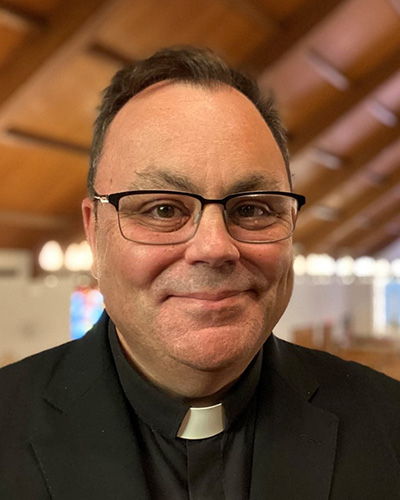“Fill us at daybreak with your kindness, that we may shout for joy and gladness all our days.”
The psalmist today calls us to shout for joy and gladness because of the Lord’s kindness to us. Our Blessed Mother was given to the church as a model of this joy and gladness. Despite the challenges, the questions, and even fears that faced her, Mary lived the words of her Magnificat. My soul proclaims the greatness of the Lord, my spirit rejoices in God, my Savior. Later this month, we will celebrate the Solemnity of the Assumption of the Blessed Virgin Mary. I offer the following reflections on both the Solemnity and how our Blessed Mother is present to us when we celebrate Holy Mass.
Mary at Mass
Devotion to Mary remains a hallmark of the Catholic faith. Some people unfamiliar with our religion assume that prayer to Mary forms the backbone of the Mass. Wrong! Prayer to Mary is certainly the backbone of the Rosary, but there isn’t a single prayer addressed to Mary in the entire Mass, front to back, on any day of the liturgical year.
When it comes to prayer, we acknowledge Hebrews 7:25 which says, “Christ lives forever to make intercession for us.” So we direct our prayers to God through Christ.
However, because of Mary’s central role in salvation history, she makes several appearances in the texts at every Mass, every day of the liturgical year.
Most important, Mary’s name is pronounced right in the heart of Mass in the Eucharistic Prayer. She is called by two titles made mystic by their juxtaposition: virgin and mother. In the second Eucharistic Prayer for children, she is also called “Mother of God and our mother.”
Mary also appears in the Creed as the virgin who conceived the Word made flesh. At times, we celebrate a Mass in her honor under a title like Mary, Mother of the Church, or to commemorate an event in her life, like the Visitation. A preface often prayed on these days echoes her song of praise, the Magnificat. But most frequently, she is remembered as the Virgin Mother.
By connecting these two titles of Mary, the church invites us to reflect on her son. Mary’s special role as the Virgin Mother reminds us that the miraculous birth of Jesus introduced the world to an extraordinary child whose miracles would never cease.
At first, the title “Mother of God” sounds wrong. God is the uncreated creator of all. How could God have a mother? That puzzling question draws us into a deeper meditation on the identity of Jesus. Because Jesus is both fully God and fully human, Mary must be called Mother of God.
In the liturgy, Mary’s role always bows to her son. She gives birth to him, not only in time, but in the liturgy and in our hearts. During the month of May, many will address devotions to Mary, and rightly so. But she will direct them to Christ.
The Catholic Church believes that Mary, the Mother of Jesus, was assumed body and soul into heaven at the end of her life. We believe in the resurrection of bodies that decay after death; Mary needed no resurrection of the body because hers was preserved from corruption. She was assumed into heaven.
This belief is a counterpart to the Catholic belief in the Immaculate Conception – to prepare a womb for the coming of the Word Made Flesh,
God preserved Mary from all sin from the moment of her conception. Mary did not experience any sin – including original sin, which leads to further sin and death. Hence, sinless (immaculate) Mary also did not experience death as other mortals do. She was assumed into heaven.
The Preface for this day was composed after the Second Vatican Council. It includes these ideas about Mary, as well as this idea about the Church: We are a pilgrim people. This image had been enshrined in the council’s Dogmatic Constitution on the Church. The entire Church makes a pilgrimage toward heaven. Mary, who achieved this goal, is a sign of hope and comfort for everyone else along the way. She is the beginning and the image of the Church as it comes to perfection.
The Mass for the Solemnity of the Assumption of the Blessed Virgin Mary is celebrated in the evening of August 14 and anytime during the day on August 15. When this solemnity falls on a Sunday, it replaces the prayers and readings of Ordinary Time. August 15 is a holyday of obligation in the United States of America, except in those years when it falls on a Saturday or a Monday.
Bulletin Inserts for the Liturgical Life of the Parish: Mary, the Saints, and Angels
© 2020 Archdiocese of Chicago: Liturgy Training Publications. All rights reserved. Written by Paul Turner.
Peace,


